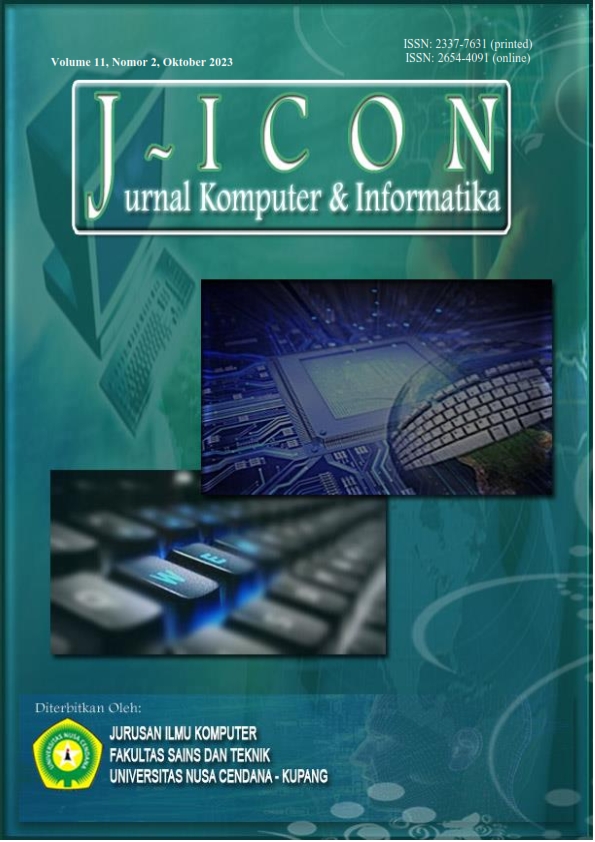EVALUATION AND REDESIGN THE WEBSITE INTERFACE USING THE USABILITY SCALE SYSTEM AND DESIGN THINKING METHOD
(Case Study: Gianyar Regency Communication and Information Service)
Abstract
The Communication and Informatics Agency of Gianyar Regency is responsible for providing information and services to the public through their official website. However, as with many organizations, they are faced with the challenge of ensuring optimal usability and quality of user experience. In this study, a usability evaluation of the official website of the Communication and Information Technology Office of Gianyar Regency was conducted using the System Usability Scale (SUS) method. The evaluation results show that their current website has a low level of usability with an average score of 45.28 (grade scale F). Furthermore, these results are used as a reference to provide a solution design to the problems faced using the Design Thinking approach. After that, testing the solution design that has been given to improve the website interface. The test results showed a significant improvement in usability, with an average score of 88.78 (grade scale A). This shows that the improvements and design changes that have been implemented have successfully improved the user experience and usability of the website of the Communication and Information Agency of Gianyar Regency.
Downloads
References
M. H. D. Adiartika and L. G. Astuti, “Usability Analysis of Udayana University SIMAK System Interface,” JELIKU (Jurnal Elektron. Ilmu Komput. Udayana), vol. 8, no. 4, p. 487, 2020, doi: 10.24843/jlk.2020.v08.i04.p15.
J. Nielsen, “Usability 101: Introduction to Usability,” Neilsen Normal Group, 2012. https://www.nngroup.com/articles/usability-101-introduction-to-usability/ (accessed Jun. 26, 2023).
Y. S. M. Putra and R. Tanamal, “Analisis Usability Menggunakan Metode USE Questionnaire Pada Website Ciputra Enterprise System,” Teknika, vol. 9, no. 1, pp. 58–65, 2020, doi: 10.34148/teknika.v9i1.267.
D. Saputra, E. Ardiyan Syah, and F. Darnis, “Usability Testing on the Simponik Website using the System Usability Scale (SUS),” Sinkron, vol. 7, no. 4, pp. 2584–2592, 2022, doi: 10.33395/sinkron.v7i4.11916.
S. A. Purnamasari, N. Heryana, and K. Prihandani, “Perbandingan Penggunaan System Usability Scale dan Usefull, Satisfaction and Ease of Use Questionnaire pada Usability Testing,” J. Ilm. Inform., vol. 6, no. 1, pp. 59–69, 2021, doi: 10.35316/jimi.v6i1.1236.
E. R. Subhiyakto, M. R. Pratiwi, and S. A. Hapsari, “Redesign Website Media Pendidikan Keluarga Menggunakan Metode Design Thinking dan Skala Kegunaan Sistem,” vol. 12, no. 1, pp. 81–94, 2023.
K. Moran, “Usability Testing 101,” Nielsen Norman Group, 2019. https://www.nngroup.com/articles/usability-testing-101/ (accessed Jun. 26, 2023).
D. Wiratama and F. Fatmasari, “Evaluasi Usability Website Pengadilan Negeri Prabumulih Menggunakan Metode Website Usability Evaluation Tool (WEBUSE),” J. Teknol. Inform. dan Komput., vol. 8, no. 2, pp. 87–100, 2022, doi: 10.37012/jtik.v8i2.1178.
J. Manajemen, S. Informasi, A. L. Dyayu, and H. Yani, “Evaluasi Usability Aplikasi PeduliLindungi Menggunakan Metode Usability Testing dan System Usability Scale ( SUS ) Jurnal Manajemen Teknologi dan Sistem Informasi ( JMS ),” vol. 3, pp. 395–404, 2023.
J. R. Lewis and J. Sauro, “Item Benchmarks for the System Usability Scale,” J. Usability Stud., vol. 13, no. January, pp. 158–167, 2018.
W. S. L. Nasution and P. Nusa, “UI/UX Design Web-Based Learning Application Using Design Thinking Method,” ARRUS J. Eng. Technol., vol. 1, no. 1, pp. 18–27, 2021, doi: 10.35877/jetech532.
Euphemia Wong, “User Interface Design Guidelines: 10 Rules of Thumb,” Interaction Design Foundation, 2022.
Copyright (c) 2023 I Kadek Tribuana Tungga Wibowo, I Putu Agus Eka Pratama

This work is licensed under a Creative Commons Attribution 4.0 International License.
The author submitting the manuscript must understand and agree that if accepted for publication, authors retain copyright and grant the journal right of first publication with the work simultaneously licensed under a Creative Commons Attribution (CC-BY) 4.0 License that allows others to share the work with an acknowledgment of the work’s authorship and initial publication in this journal.
 I Kadek Tribuana Tungga Wibowo(1*)
I Kadek Tribuana Tungga Wibowo(1*)




